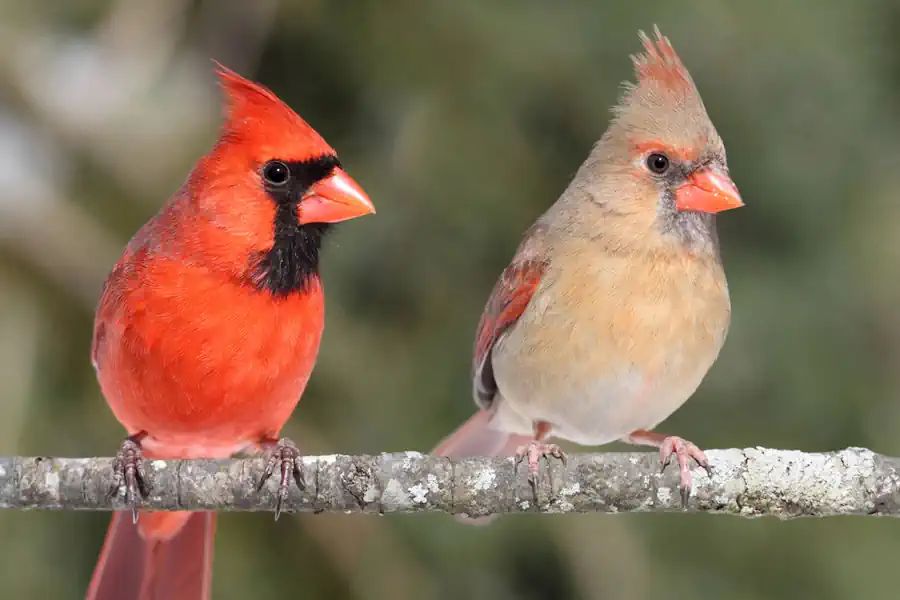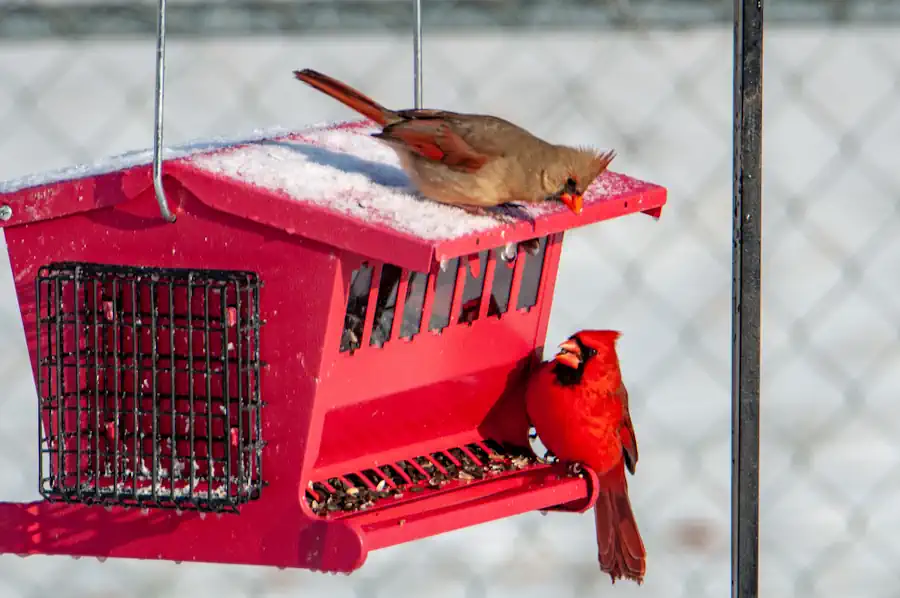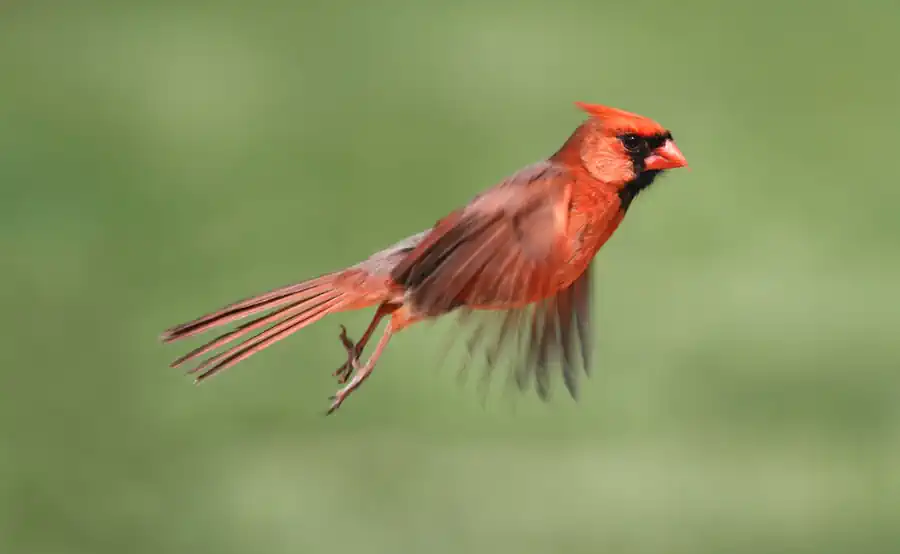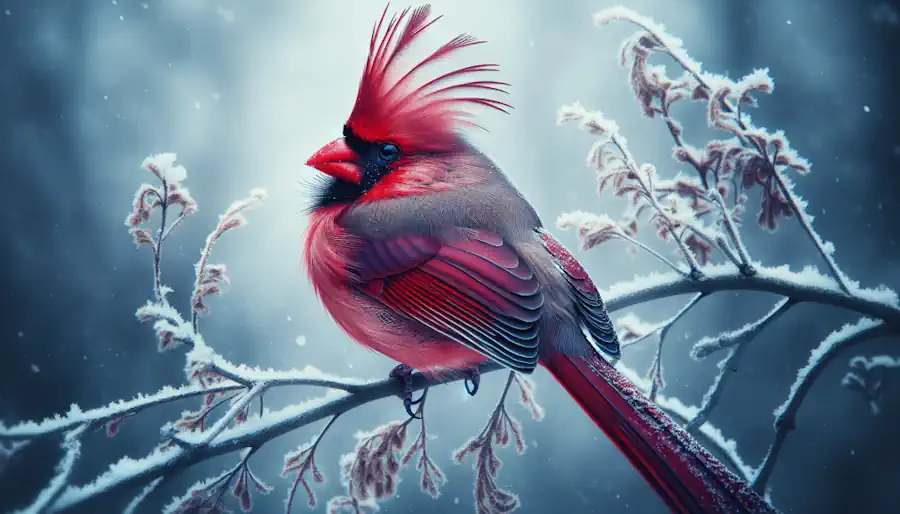Let’s take a moment to appreciate the Beautiful Northern Cardinal, a stunning and charismatic bird that can truly take your breath away. With its vibrant red plumage and distinctive crest, this avian beauty stands out in any backyard or forest.

Found across North America, the Northern Cardinal never fails to captivate with its melodious song and graceful flight. Whether you’re an avid birdwatcher or simply enjoy the wonders of nature, the Beautiful Northern Cardinal is a sight to behold.
Physical Appearance
The Northern Cardinal is a strikingly beautiful bird, known for its vibrant red plumage. The males are particularly eye-catching, with their bright red feathers that cover most of their bodies. The females, on the other hand, have a more subtle combination of grayish-brown and red feathers.
Both males and females have a crest on their heads that can be raised or lowered depending on their mood or level of excitement. This crested head adds to their regal and distinctive appearance. The Northern Cardinal also has a short, strong beak that is perfectly adapted for its feeding habits.
Habitat
Range
The Northern Cardinal is primarily found in North America. Its range extends from the eastern parts of the United States, including the Gulf Coast states, all the way up to southern Canada. It is also introduced in other regions such as California, Hawaii, and Bermuda. Although the Northern Cardinal is native to North America, its striking appearance has made it a popular bird in various parts of the world.
Preferred Habitats
Northern Cardinals can adapt to a wide range of habitats, from forests and woodlands to suburban gardens. They are commonly found in areas with dense vegetation, as it provides them with plenty of cover and nesting sites. They are also known to frequent bird feeders during the winter months when food sources may become scarce.
Diet
Seeds and Fruits
The primary diet of the Northern Cardinal consists of seeds and fruits. They have a strong beak that enables them to crack open hard shells and extract the nutritious contents inside. Cardinals have been observed feeding on a variety of seeds, including those from sunflowers, cherries, and dogwoods. They are also known to forage for berries and other fruits when available.
Insects and Invertebrates
In addition to seeds and fruits, Northern Cardinals also consume insects and invertebrates. These include beetles, grasshoppers, and spiders, among others. Insects and invertebrates provide a valuable source of protein for the Cardinals, especially during the breeding season when they need to nourish their young.
Breeding
Monogamous Pairs
Northern Cardinals are known for their lifelong monogamous pairings. Once they find a mate, they will remain together for the rest of their lives. This strong bond between the male and female Cardinals helps ensure the successful rearing of their offspring.
Nest Building
The female Northern Cardinal is responsible for building the nest, which is typically located in dense shrubs or bushes. The nest is built using twigs, grass, leaves, and other plant materials and is usually lined with softer materials such as feathers or animal fur. The structure of the nest provides protection and shelter for the eggs and nestlings.
Egg Laying and Incubation
After the nest is constructed, the female will lay a clutch of usually three to four eggs. The eggs are a light bluish-green color with speckles. The female takes on the primary responsibility of incubating the eggs, while the male provides her with food during this period. Incubation typically lasts around 12 to 13 days.
Fledgling and Parental Care
Once the eggs hatch, both parents take on the task of feeding and caring for the nestlings. Both the male and female Cardinals actively seek out insects and other food sources to ensure their young are adequately nourished. The nestlings will remain in the nest for approximately 9 to 11 days before they are ready to fledge. During this time, the parents teach them how to fly and find food.
Behavior
Territorial
Northern Cardinals are known to be territorial birds, especially during the breeding season. Males will defend their territory vigorously against other males, often engaging in aggressive displays and vocalizations. The females also play a role in defending their territory, especially once they have built a nest and laid eggs.
Song and Vocalization
The Northern Cardinal is known for its melodious song, which consists of a series of clear, whistling notes. The song is often described as a series of short phrases that sound like “cheer, cheer, cheer” or “birdie, birdie, birdie.” Both males and females sing, with the males having a more varied and complex song repertoire.

Feeding Behavior
The Northern Cardinal is a ground feeder and typically forages by hopping along the ground in search of seeds, fruits, and insects. They have also been observed feeding on plants and flowers, extracting nectar from them. Their strong beak allows them to easily crack open seeds and extract the nutritious contents.
Do Cardinals Migrate? Year-Round Residents vs. Partial Migrants
Year-round Residents
While some Northern Cardinals migrate during the winter months, many populations are year-round residents in their respective habitats. In regions with milder winters, such as the southern parts of their range, they can be found throughout the year.
This sedentary behavior distinguishes them from many other North American bird species that undertake long-distance migrations. Cardinals are well-adapted to harsh winter conditions, with their thick plumage providing excellent insulation against cold temperatures.
Partial Migration
Northern Cardinals exhibit what ornithologists call “partial migration,” with some individuals choosing to migrate while others remain in their breeding grounds year-round. This migration pattern is primarily driven by geographic location, with cardinals in the northernmost parts of their range more likely to migrate than those in southern regions. Young cardinals (juveniles) are more likely to migrate than mature adults, who tend to maintain established territories.
Seasonal Movement Factors
The decision to migrate or remain resident depends on several key factors:
- Food availability: Cardinals may move short distances when seed sources become scarce
- Temperature variations: Extreme cold snaps may trigger temporary movements
- Breeding territory establishment: Young birds may disperse to find suitable breeding grounds
- Urban vs. rural habitats: Cardinals in urban environments with reliable food sources (bird feeders) are less likely to migrate
Migration Distances and Patterns
When Northern Cardinals do migrate, their movements are typically short-distance dispersals rather than long-distance migrations. They may move:
- 50-100 miles southward during severe winters
- To lower elevations in mountainous regions
- From rural areas to suburban zones with more abundant food sources
- Between different habitat types within their range

Northern Range Shift
Over the past several decades, there has been a noticeable shift in the Northern Cardinal’s range, particularly the northern edge of their habitat. As temperatures warm due to climate change, Cardinals have been observed expanding their range further north. This northward shift reflects the Cardinals’ ability to adapt to changing environmental conditions.
This expansion represents the opposite of traditional migration – instead of moving south for winter, cardinals are now establishing year-round populations further north than historically possible. The species has expanded into:
- Southern Canada (Ontario, Quebec)
- Northern New England states
- Upper Midwest regions
- Previously uninhabitable northern territories
Migratory vs. Non-Migratory Populations
Research has identified distinct behavioral differences between migratory and non-migratory cardinal populations. Non-migratory cardinals tend to:
- Have larger home ranges
- Store more fat reserves for winter survival
- Develop stronger pair bonds and territory attachment
- Show less genetic diversity due to reduced gene flow
Migratory populations often exhibit:
- More flexible feeding behaviors
- Greater adaptability to changing environments
- Seasonal changes in flock composition
- Different hormonal responses to photoperiod changes

Predators and Threats
Birds of Prey
Northern Cardinals face predation from a variety of bird species, including hawks, owls, and other birds of prey. These predators pose a threat to both adults and nestlings. Cardinals rely on their camouflage and dense vegetation for protection against aerial predators.
Domestic Cats and Dogs
Another significant threat to Northern Cardinals comes from domestic cats and dogs. These pets may prey upon Cardinals, especially when they venture into residential areas. It is crucial for pet owners to be vigilant and keep their pets indoors or supervised when Cardinals and other birds are present.
Habitat Loss
As with many bird species, habitat loss is a significant threat to the Northern Cardinal’s population. Deforestation, urbanization, and the destruction of nesting sites have contributed to declining populations in certain areas. Conserving and protecting their preferred habitats is crucial for ensuring the long-term survival of this beautiful bird.
Conservation Status
Population Trends
The population of Northern Cardinals is considered stable, with some variations in different regions. While deforestation and habitat loss have impacted some populations, the overall numbers remain healthy. The adaptability of this species to a variety of habitats has contributed to its resilience.
Protected Species
The Northern Cardinal is not currently listed as a federally protected species in the United States. However, it is still important to implement conservation measures and protect their habitats to ensure their continued presence in our ecosystems.
Human Interaction
Symbolic Representation
The Northern Cardinal holds significant symbolism in various cultures and traditions. Its vibrant red plumage is often associated with vitality, energy, and the spirit of life. In some Native American tribes, the sight of a Cardinal is believed to bring good luck or a message from a departed loved one.
Feeding and Observation
Many people enjoy attracting Northern Cardinals to their backyards by providing bird feeders filled with seeds, fruits, and other foods they enjoy. Observing Cardinals in their natural habitat can be a rewarding experience, as their vibrant colors and beautiful songs can brighten any day. However, it’s essential to maintain responsible feeding practices and ensure that the food provided is suitable for the birds’ health.

Helping Northern Cardinals Thrive
The Northern Cardinal is truly a magnificent bird that captivates us with its vibrant plumage, melodious song, and interesting behaviors. Its ability to adapt to various habitats and its resilience in the face of environmental changes make it a species worth appreciating and protecting. By preserving their habitats, practicing responsible bird feeding, and taking steps to mitigate threats, we can ensure that future generations will continue to enjoy the beauty and charm of the Northern Cardinal.
